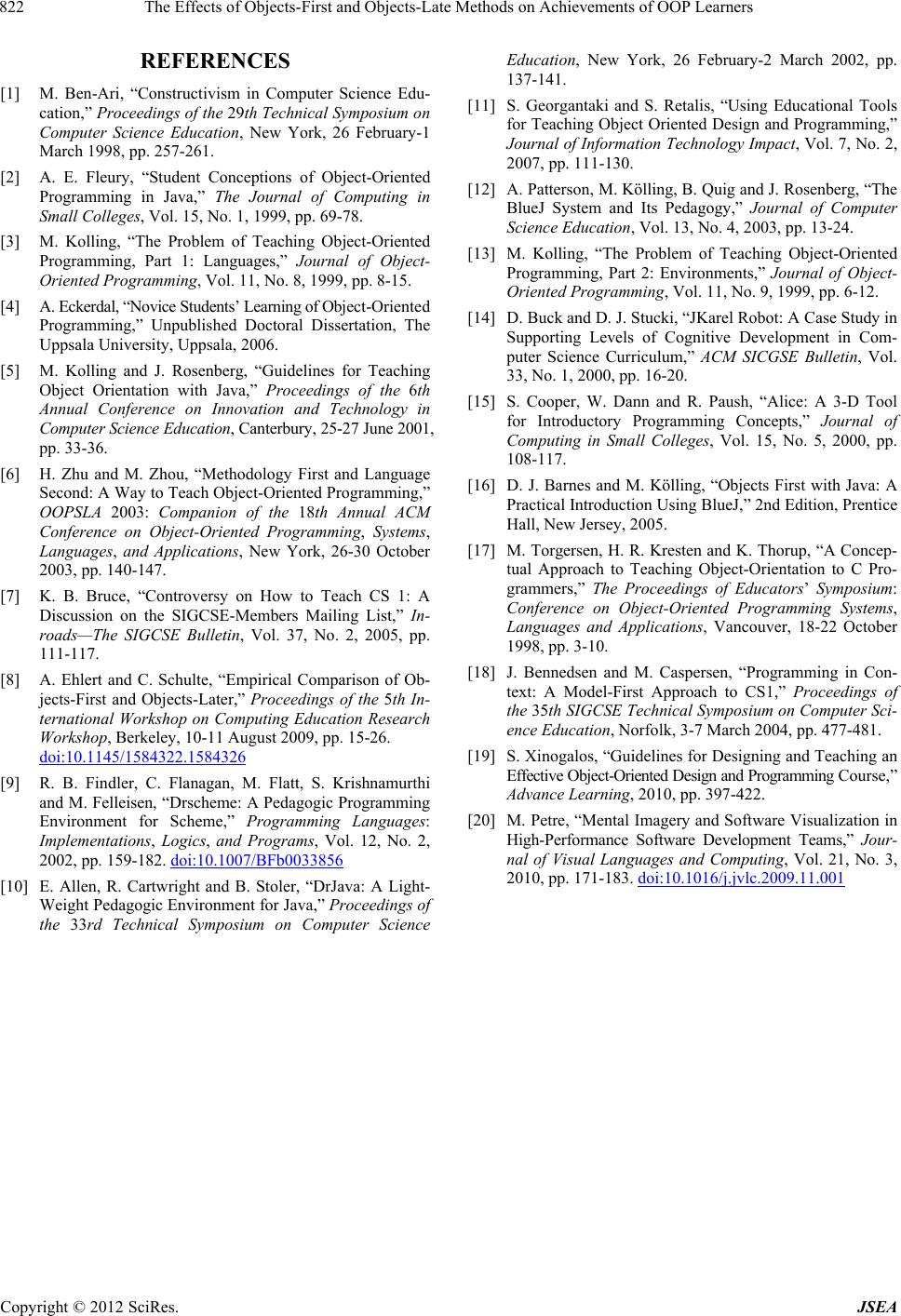
The Effects of Objects-First and Objects-Late Methods on Achievements of OOP Learners
Copyright © 2012 SciRes. JSEA
822
REFERENCES
[1] M. Ben-Ari, “Constructivism in Computer Science Edu-
cation,” Proceedings of the 29th Technical Symposium on
Computer Science Education, New York, 26 February-1
March 1998, pp. 257-261.
[2] A. E. Fleury, “Student Conceptions of Object-Oriented
Programming in Java,” The Journal of Computing in
Small Colleges, Vol. 15, No. 1, 1999, pp. 69-78.
[3] M. Kolling, “The Problem of Teaching Object-Oriented
Programming, Part 1: Languages,” Journal of Object-
Oriented Programming, Vol. 11, No. 8, 1999, pp. 8-15.
[4] A. Eckerdal, “Novice Students’ Learning of Object-Oriented
Programming,” Unpublished Doctoral Dissertation, The
Uppsala University, Uppsala, 2006.
[5] M. Kolling and J. Rosenberg, “Guidelines for Teaching
Object Orientation with Java,” Proceedings of the 6th
Annual Conference on Innovation and Technology in
Computer Science Education, Canterbury , 25-27 Ju ne 2001,
pp. 33-36.
[6] H. Zhu and M. Zhou, “Methodology First and Language
Second: A Way to Teach Object-Oriented Programming,”
OOPSLA 2003: Companion of the 18th Annual ACM
Conference on Object-Oriented Programming, Systems,
Languages, and Applications, New York, 26-30 October
2003, pp. 140-147.
[7] K. B. Bruce, “Controversy on How to Teach CS 1: A
Discussion on the SIGCSE-Members Mailing List,” In-
roads—The SIGCSE Bulletin, Vol. 37, No. 2, 2005, pp.
111-117.
[8] A. Ehlert and C. Schulte, “Empirical Comparison of Ob-
jects-First and Objects-Later,” Proceedings of the 5th In-
ternational Workshop on Computing Education Research
Workshop, Berkeley, 10-11 August 2009, pp. 15-26.
doi:10.1145/1584322.1584326
[9] R. B. Findler, C. Flanagan, M. Flatt, S. Krishnamurthi
and M. Felleisen, “Drscheme: A Pedagogic Programming
Environment for Scheme,” Programming Languages:
Implementations, Logics, and Programs, Vol. 12, No. 2,
2002, pp. 159-182. doi:10.1007/BFb0033856
[10] E. Allen, R. Cartwright and B. Stoler, “DrJava: A Light-
Weight Pedagogic Environment for Java,” Proceedings of
the 33rd Technical Symposium on Computer Science
Education, New York, 26 February-2 March 2002, pp.
137-141.
[11] S. Georgantaki and S. Retalis, “Using Educational Tools
for Teaching Object Oriented Design and Programming,”
Journal of Information Technology Impact, Vol. 7, No. 2,
2007, pp. 111-130.
[12] A. Patterson, M. Kölling, B. Quig and J. Rosenberg, “The
BlueJ System and Its Pedagogy,” Journal of Computer
Science Education, Vol. 13, No. 4, 2003, pp. 13-24.
[13] M. Kolling, “The Problem of Teaching Object-Oriented
Programming, Part 2: Environments,” Journal of Object-
Oriented Programming, Vol. 11, No. 9, 1999, pp. 6-12.
[14] D. Buck and D. J. Stucki, “JKarel Robot: A Case Study in
Supporting Levels of Cognitive Development in Com-
puter Science Curriculum,” ACM SICGSE Bulletin, Vol.
33, No. 1, 2000, pp. 16-20.
[15] S. Cooper, W. Dann and R. Paush, “Alice: A 3-D Tool
for Introductory Programming Concepts,” Journal of
Computing in Small Colleges, Vol. 15, No. 5, 2000, pp.
108-117.
[16] D. J. Barnes and M. Kölling, “Objects First with Java: A
Practical Introduction Using BlueJ,” 2nd Edition, Prentice
Hall, New Jersey, 2005.
[17] M. Torgersen, H. R. Kresten and K. Thorup, “A Concep-
tual Approach to Teaching Object-Orientation to C Pro-
grammers,” The Proceedings of Educators’ Symposium:
Conference on Object-Oriented Programming Systems,
Languages and Applications, Vancouver, 18-22 October
1998, pp. 3-10.
[18] J. Bennedsen and M. Caspersen, “Programming in Con-
text: A Model-First Approach to CS1,” Proceedings of
the 35th SIGCSE Technical Symposium on Computer Sci-
ence Education, Norfolk, 3-7 March 2004, pp. 477-481.
[19] S. Xinogalos, “Guidelines for Designing and Teaching an
Effective Object-Oriented Design and Programming C our se,”
Advance Learning, 2010, pp. 397-422.
[20] M. Petre, “Mental Imagery and Software Visualization in
High-Performance Software Development Teams,” Jour-
nal of Visual Languages and Computing, Vol. 21, No. 3,
2010, pp. 171-183. doi:10.1016/j.jvlc.2009.11.001